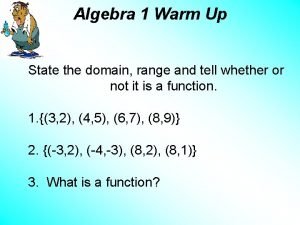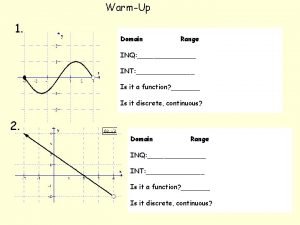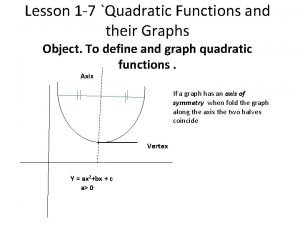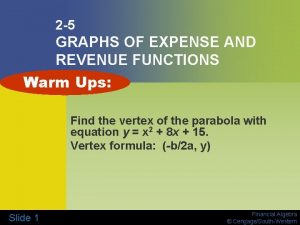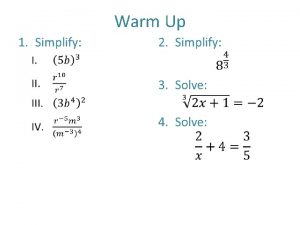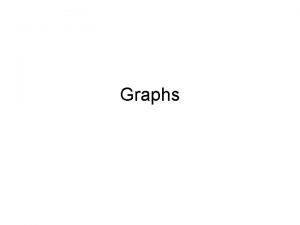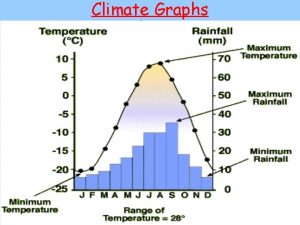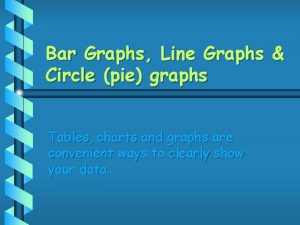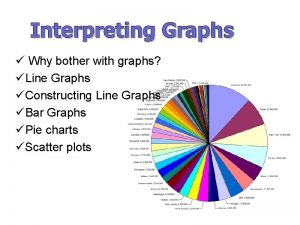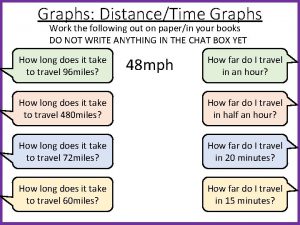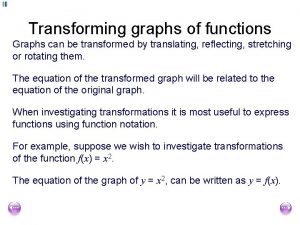Warm Up Are the following graphs functions Explain





















- Slides: 21

Warm Up – Are the following graphs functions: Explain why or why not. 6) Create a relation with at least 5 ordered pairs that is a function.

HW Check 3. 3

Interpreting Graphs

A. This graph shows the relationship between time and the depth of water in a leaky swimming pool. • What is the initial depth of the water? • For what time interval(s) is the water level decreasing? What accounts for the decrease(s)? • For what time interval(s) is the water level increasing? What accounts for the increase(s)? • Is the pool ever empty? How can you tell? • The Domain is____________. • The Range is _____________.

In this example, the _depth of the water_ is a function of_time_. That is, the _depth_ depends on how much _time_ has passed. So, in this case, depth is called the _Dependent Variable_. Time is the _independent variable_. When you draw a graph, put the independent variable on the _x-axis_ and put the dependent variable on the _y-axis_.

The values of the range depend on the values of the domain. If you know the value of the independent variable, you can determine the corresponding value of the dependent variable. You do this every time you locate a point on the graph of a function.

• B. This graph shows the volume of air in a balloon as it changes over time. • What is the independent variable? How is it measured? • What is the dependent variable? How is it measured? • For what intervals is the volume increasing? What accounts for the increases? • For what intervals is the volume decreasing? What accounts for the decreases? • For what intervals is the volume constant? What accounts for this? • What is happening for the first 2 seconds? The Domain is____________. • The Range is ____________

Matching Up: The graphs below show increasing functions, meaning that as the x-values increase, the yvalues also increase. In Graph A, the function values increase at a constant rate. In Graph B, the values increase slowly at first and then more quickly. In Graph C, the function switches from one constant rate of increase to another.

The graphs below show decreasing functions, meaning that as the x-values increase, the y-values decrease. In Graph D, the function values decrease at a constant rate. In Graph E, the values decrease quickly at first and then more slowly. In Graph F, the function switches from one constant rate of decrease to another.

The graphs below show functions that have both increasing and decreasing intervals. In Graph G, the function values decrease at a constant rate at first and then increase at a constant rate. In Graph H, the values increase slowly at first and then more quickly and then begin to decrease quickly at first and then more slowly. In Graph I, the function oscillates between two values.

White Tiger Population • A small group of endangered white tigers are brought to a special reserve. The group of tigers reproduces slowly at first, and then as more and more tigers mature, the population grows more quickly. • Independent Variable: • Dependent Variable: • Matching Graph:

Temperature of Hot Tea • Grandma pours a cup of hot tea into a tea cup. The temperature at first is very hot, but cools off quickly as the cup sits on the table. As the temperature of the tea approaches room temperature, it cools off more slowly. • Independent Variable: • Dependent Variable: • Matching Graph:

Number of Daylight Hours over a Year’s Time • In January, the beginning of the year, we are in the middle of winter and the number of daylight hours is at its lowest point. Then the number of daylight hours increases slowly at first through the rest of winter and early spring. As summer approaches, the number of daylight hours increases more quickly, then levels off and reaches a maximum value, then decreases quickly, and then decreases more slowly into fall and early winter. • Independent Variable: • Dependent Variable: • Matching Graph:

Height of a Person Above Ground Who is Riding a Ferris Wheel • When a girl gets on a Ferris wheel, she is 10 feet above ground. As the Ferris wheel turns, she gets higher and higher until she reaches the top. Then she starts to descend until she reaches the bottom and starts going up again. • Independent Variable: • Dependent Variable: • Matching Graph:

Continuous v. Discrete? • Functions that have smooth graphs, with no breaks in the domain or range, are called continuous functions. • Functions that are not continuous often involve quantities—such as people, cars, or stories of a building—that are counted or measured in whole numbers. Such functions are called discrete functions.

Discrete Continuous

Domain and Range of Continuous Functions

Domain and Range of Continuous Graphs

Domain and Range of Continuous Function

Rate of Change Worksheet

Coming up…. • HW 3. 4 • Project due tomorrow!!
 Insidan region jh
Insidan region jh Polynomial end behavior chart
Polynomial end behavior chart Motion graphs warm up answer key
Motion graphs warm up answer key What is state graph in software testing
What is state graph in software testing Graphs that compare distance and time are called
Graphs that compare distance and time are called Graphs that enlighten and graphs that deceive
Graphs that enlighten and graphs that deceive Domain and range warm up
Domain and range warm up What is the domain and range of the function
What is the domain and range of the function Cho sha cao
Cho sha cao Vertical stretch vs vertical shrink
Vertical stretch vs vertical shrink Graphs of hyperbolic functions
Graphs of hyperbolic functions Structure in graphs of polynomial functions
Structure in graphs of polynomial functions Horizontal asymptote rule
Horizontal asymptote rule Quadratic functions and their graphs
Quadratic functions and their graphs 1-2 analyzing graphs of functions and relations answers
1-2 analyzing graphs of functions and relations answers Practice a investigating graphs of polynomial functions
Practice a investigating graphs of polynomial functions Investigating graphs of polynomial functions
Investigating graphs of polynomial functions Sketching graphs of quadratic functions
Sketching graphs of quadratic functions 8-3 rational functions and their graphs
8-3 rational functions and their graphs Algebra graphs and functions
Algebra graphs and functions Revenue function graph
Revenue function graph Analyzing graphs of functions and relations
Analyzing graphs of functions and relations






